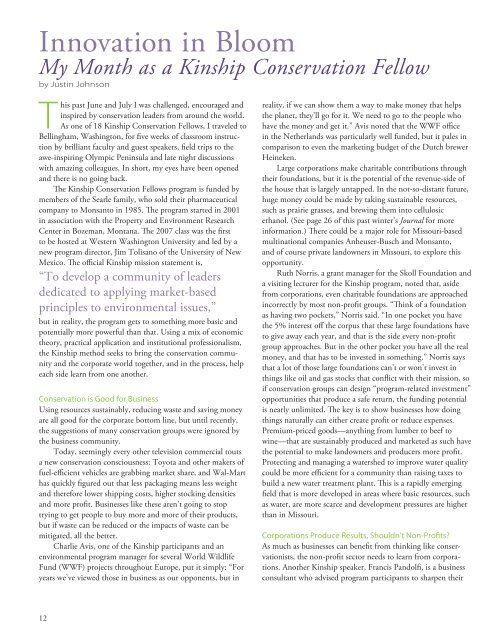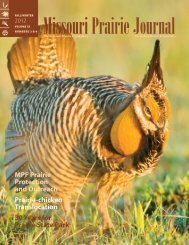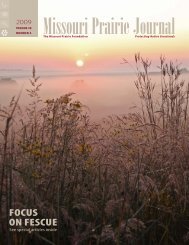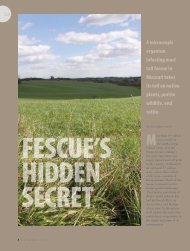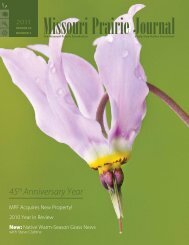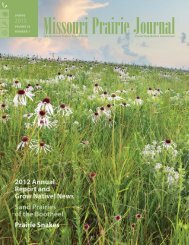Summer 2007: Volume 28, Number 3 - Missouri Prairie Foundation
Summer 2007: Volume 28, Number 3 - Missouri Prairie Foundation
Summer 2007: Volume 28, Number 3 - Missouri Prairie Foundation
- No tags were found...
You also want an ePaper? Increase the reach of your titles
YUMPU automatically turns print PDFs into web optimized ePapers that Google loves.
Innovation in BloomMy Month as a Kinship Conservation Fellowby Justin JohnsonThis past June and July I was challenged, encouraged andinspired by conservation leaders from around the world.As one of 18 Kinship Conservation Fellows, I traveled toBellingham, Washington, for five weeks of classroom instructionby brilliant faculty and guest speakers, field trips to theawe-inspiring Olympic Peninsula and late night discussionswith amazing colleagues. In short, my eyes have been openedand there is no going back.The Kinship Conservation Fellows program is funded bymembers of the Searle family, who sold their pharmaceuticalcompany to Monsanto in 1985. The program started in 2001in association with the Property and Environment ResearchCenter in Bozeman, Montana. The <strong>2007</strong> class was the firstto be hosted at Western Washington University and led by anew program director, Jim Tolisano of the University of NewMexico. The official Kinship mission statement is,“To develop a community of leadersdedicated to applying market-basedprinciples to environmental issues,”but in reality, the program gets to something more basic andpotentially more powerful than that. Using a mix of economictheory, practical application and institutional professionalism,the Kinship method seeks to bring the conservation communityand the corporate world together, and in the process, helpeach side learn from one another.Conservation is Good for BusinessUsing resources sustainably, reducing waste and saving moneyare all good for the corporate bottom line, but until recently,the suggestions of many conservation groups were ignored bythe business community.Today, seemingly every other television commercial toutsa new conservation consciousness: Toyota and other makers offuel-efficient vehicles are grabbing market share, and Wal-Marthas quickly figured out that less packaging means less weightand therefore lower shipping costs, higher stocking densitiesand more profit. Businesses like these aren’t going to stoptrying to get people to buy more and more of their products,but if waste can be reduced or the impacts of waste can bemitigated, all the better.Charlie Avis, one of the Kinship participants and anenvironmental program manager for several World WildlifeFund (WWF) projects throughout Europe, put it simply: “Foryears we’ve viewed those in business as our opponents, but inreality, if we can show them a way to make money that helpsthe planet, they’ll go for it. We need to go to the people whohave the money and get it.” Avis noted that the WWF officein the Netherlands was particularly well funded, but it pales incomparison to even the marketing budget of the Dutch brewerHeineken.Large corporations make charitable contributions throughtheir foundations, but it is the potential of the revenue-side ofthe house that is largely untapped. In the not-so-distant future,huge money could be made by taking sustainable resources,such as prairie grasses, and brewing them into cellulosicethanol. (See page 26 of this past winter’s Journal for moreinformation.) There could be a major role for <strong>Missouri</strong>-basedmultinational companies Anheuser-Busch and Monsanto,and of course private landowners in <strong>Missouri</strong>, to explore thisopportunity.Ruth Norris, a grant manager for the Skoll <strong>Foundation</strong> anda visiting lecturer for the Kinship program, noted that, asidefrom corporations, even charitable foundations are approachedincorrectly by most non-profit groups. “Think of a foundationas having two pockets,” Norris said. “In one pocket you havethe 5% interest off the corpus that these large foundations haveto give away each year, and that is the side every non-profitgroup approaches. But in the other pocket you have all the realmoney, and that has to be invested in something.” Norris saysthat a lot of those large foundations can’t or won’t invest inthings like oil and gas stocks that conflict with their mission, soif conservation groups can design “program-related investment”opportunities that produce a safe return, the funding potentialis nearly unlimited. The key is to show businesses how doingthings naturally can either create profit or reduce expenses.Premium-priced goods—anything from lumber to beef towine—that are sustainably produced and marketed as such havethe potential to make landowners and producers more profit.Protecting and managing a watershed to improve water qualitycould be more efficient for a community than raising taxes tobuild a new water treatment plant. This is a rapidly emergingfield that is more developed in areas where basic resources, suchas water, are more scarce and development pressures are higherthan in <strong>Missouri</strong>.Corporations Produce Results, Shouldn’t Non-Profits?As much as businesses can benefit from thinking like conservationists,the non-profit sector needs to learn from corporations.Another Kinship speaker, Francis Pandolfi, is a businessconsultant who advised program participants to sharpen their12


